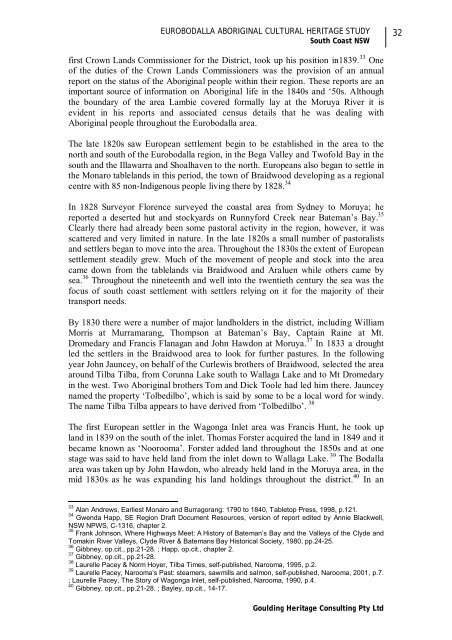Pages 9 - 77 (1600kb) - Eurobodalla Shire Council
Pages 9 - 77 (1600kb) - Eurobodalla Shire Council
Pages 9 - 77 (1600kb) - Eurobodalla Shire Council
Create successful ePaper yourself
Turn your PDF publications into a flip-book with our unique Google optimized e-Paper software.
EUROBODALLA ABORIGINAL CULTURAL HERITAGE STUDY<br />
South Coast NSW<br />
first Crown Lands Commissioner for the District, took up his position in1839. 33 One<br />
of the duties of the Crown Lands Commissioners was the provision of an annual<br />
report on the status of the Aboriginal people within their region. These reports are an<br />
important source of information on Aboriginal life in the 1840s and ‘50s. Although<br />
the boundary of the area Lambie covered formally lay at the Moruya River it is<br />
evident in his reports and associated census details that he was dealing with<br />
Aboriginal people throughout the <strong>Eurobodalla</strong> area.<br />
The late 1820s saw European settlement begin to be established in the area to the<br />
north and south of the <strong>Eurobodalla</strong> region, in the Bega Valley and Twofold Bay in the<br />
south and the Illawarra and Shoalhaven to the north. Europeans also began to settle in<br />
the Monaro tablelands in this period, the town of Braidwood developing as a regional<br />
centre with 85 non-Indigenous people living there by 1828. 34<br />
In 1828 Surveyor Florence surveyed the coastal area from Sydney to Moruya; he<br />
reported a deserted hut and stockyards on Runnyford Creek near Bateman’s Bay. 35<br />
Clearly there had already been some pastoral activity in the region, however, it was<br />
scattered and very limited in nature. In the late 1820s a small number of pastoralists<br />
and settlers began to move into the area. Throughout the 1830s the extent of European<br />
settlement steadily grew. Much of the movement of people and stock into the area<br />
came down from the tablelands via Braidwood and Araluen while others came by<br />
sea. 36 Throughout the nineteenth and well into the twentieth century the sea was the<br />
focus of south coast settlement with settlers relying on it for the majority of their<br />
transport needs.<br />
By 1830 there were a number of major landholders in the district, including William<br />
Morris at Murramarang, Thompson at Bateman’s Bay, Captain Raine at Mt.<br />
Dromedary and Francis Flanagan and John Hawdon at Moruya. 37 In 1833 a drought<br />
led the settlers in the Braidwood area to look for further pastures. In the following<br />
year John Jauncey, on behalf of the Curlewis brothers of Braidwood, selected the area<br />
around Tilba Tilba, from Corunna Lake south to Wallaga Lake and to Mt Dromedary<br />
in the west. Two Aboriginal brothers Tom and Dick Toole had led him there. Jauncey<br />
named the property ‘Tolbedilbo’, which is said by some to be a local word for windy.<br />
The name Tilba Tilba appears to have derived from ‘Tolbedilbo’. 38<br />
The first European settler in the Wagonga Inlet area was Francis Hunt, he took up<br />
land in 1839 on the south of the inlet. Thomas Forster acquired the land in 1849 and it<br />
became known as ‘Noorooma’. Forster added land throughout the 1850s and at one<br />
stage was said to have held land from the inlet down to Wallaga Lake. 39 The Bodalla<br />
area was taken up by John Hawdon, who already held land in the Moruya area, in the<br />
mid 1830s as he was expanding his land holdings throughout the district. 40 In an<br />
33 Alan Andrews, Earliest Monaro and Burragorang: 1790 to 1840, Tabletop Press, 1998, p.121.<br />
34 Gwenda Happ, SE Region Draft Document Resources, version of report edited by Annie Blackwell,<br />
NSW NPWS, C-1316, chapter 2.<br />
35 Frank Johnson, Where Highways Meet: A History of Bateman’s Bay and the Valleys of the Clyde and<br />
Tomakin River Valleys, Clyde River & Batemans Bay Historical Society, 1980, pp.24-25.<br />
36 Gibbney, op.cit., pp.21-28. ; Happ, op.cit., chapter 2.<br />
37 Gibbney, op.cit., pp.21-28.<br />
38 Laurelle Pacey & Norm Hoyer, Tilba Times, self-published, Narooma, 1995, p.2.<br />
39 Laurelle Pacey, Narooma’s Past: steamers, sawmills and salmon, self-published, Narooma, 2001, p.7.<br />
; Laurelle Pacey, The Story of Wagonga Inlet, self-published, Narooma, 1990, p.4.<br />
40 Gibbney, op.cit., pp.21-28. ; Bayley, op.cit., 14-17.<br />
Goulding Heritage Consulting Pty Ltd<br />
32
















